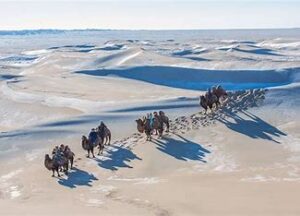
Here are 10 most beautiful places for visitors in Bolivia that are must-visit destinations for travelers. Bolivia is home to a diverse range of stunning landscapes and natural wonders.
1. Salar de Uyuni:
2. Laguna Colorada:
3. Lake Titicaca:
4. Death Road (Yungas Road):
5. Torotoro National Park:
6. Potosí:
7. Madidi National Park:
8. Oruro Carnival:
9. Valle de la Luna (Moon Valley):
10. Sajama National Park:
1. Salar de Uyuni, Bolivia:
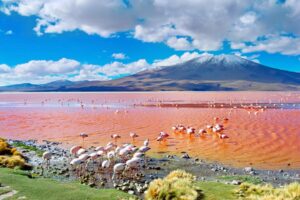
Salar de Uyuni, located in southwest Bolivia, is the largest salt flat in the world and one of the top 10 most beautiful places for visitors.
It covers more than 10,000 square kilometers, making it a must-see spot for travelers looking for adventure and amazing scenery.
The salt flat was formed from ancient lakes and is known for its vast, flat white salt crust, which creates a dreamlike, otherworldly feel.
A popular activity here is taking a guided tour across the flats, where visitors can not only admire the unique salt patterns but also visit the famous “Salt Hotel” and, of course, snap breathtaking photos.
The landscape looks especially stunning at sunrise and sunset when the colors are vibrant and the view is unforgettable. During the rainy season, a thin layer of water on the flats creates a perfect mirror effect, reflecting the sky above.
Aside from the salt flats, the area is home to other interesting sites like Incahuasi Island, which is covered in giant cacti and offers beautiful views. Travelers can also visit Eduardo Avaroa National Park, known for its colorful lagoons, geysers, and wildlife like flamingos.
For those wanting to experience local culture, the nearby town of Uyuni offers markets, restaurants, and, moreover, a chance to learn about Bolivian traditions. With its stunning landscapes and rich culture, Salar de Uyuni is a truly unforgettable destination.
2. Laguna Colorada, Bolivia:
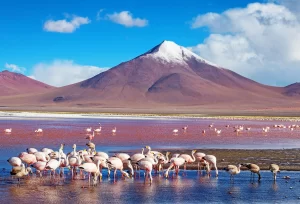
Laguna Colorada, located in the Eduardo Avaroa Andean Fauna National Reserve in Bolivia, is considered one of the 10 most beautiful places in the world that attracts visitors.
This breathtaking red lagoon attracts visitors from all over the globe, thanks to its vibrant colors, which come from red algae and sediment in the water.
The lagoon is surrounded by stunning scenery, including snow-capped mountains, vast salt flats, and unique rock formations, making it a dream spot for photographers.
One of the highlights of Laguna Colorada is the wildlife it hosts, especially the flamingos. Several species, including the James’s flamingo, can be seen wading through the lagoon’s shallow waters.
Nature lovers and birdwatchers will enjoy spotting other wildlife like llamas, vicuñas, and various birds.
Visitors can enjoy activities such as hiking, photography, and guided tours to explore the beautiful surroundings.
The best time to visit is during the dry season, from May to October when the weather is more stable and the lagoon’s colors are at their most vivid.
Accommodations in the area vary from simple hostels to more comfortable lodges, so travelers can choose based on their preferences.
It’s important to respect the delicate ecosystem and, furthermore, follow local guidelines to help preserve this unique environment.
A trip to Laguna Colorada offers an unforgettable experience, showcasing the remarkable beauty of Bolivia’s high-altitude landscapes.
3. Lake Titicaca, Bolivia:
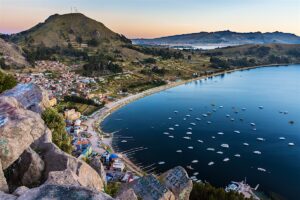
Lake Titicaca, located on the border between Bolivia and Peru, is one of the top 10 most beautiful places for visitors. It’s the highest navigable lake in the world, sitting at an impressive 3,812 meters (12,507 feet) above sea level.
This stunning lake isn’t just a natural wonder—it’s also a cultural gem, full of history and tradition.
For travelers, Lake Titicaca offers a perfect mix of breathtaking views, vibrant indigenous cultures, and plenty of activities to enjoy.
Visitors can explore the beautiful islands on the lake, such as Isla del Sol and Isla de la Luna, which are both rich in Inca mythology.
Isla del Sol, considered the birthplace of the sun in Inca beliefs, features ancient ruins and scenic hiking trails with stunning views of the lake.
The floating Uros Islands, made entirely of totora reeds, offer a fascinating insight into the lives of the Uros people, who have lived on the lake for centuries.
For those seeking adventure, there’s kayaking, sailing, and hiking to enjoy.
The area is also home to diverse wildlife, making it a fantastic spot for birdwatching.
Food lovers can try local dishes, including fresh trout from the lake and traditional Bolivian meals.
With its breathtaking landscapes, rich cultural heritage, and endless activities, Lake Titicaca is a must-see destination for anyone looking for an unforgettable experience in Bolivia.
Whether you’re exploring local traditions or simply soaking in the peaceful beauty of the lake, Lake Titicaca offers an enriching adventure.
4. Death Road (Yungas Road), Bolivia:
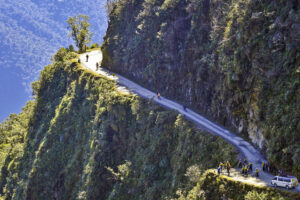
Death Road, officially known as Yungas Road, is a famous destination in Bolivia known for its stunning views and thrilling adventure opportunities.
Stretching about 64 kilometers (40 miles) from La Paz to Coroico, this road is often considered one of the most dangerous in the world, thanks to its cliffs, narrow paths, and unpredictable weather.
Despite its dangerous reputation, it has become a popular spot for tourists seeking an adrenaline rush.
As you travel along Yungas Road, you’ll be treated to breathtaking views of the lush Amazon rainforest, dramatic mountains, and, not to mention, beautiful waterfalls.
The landscape changes drastically as you descend from the high-altitude plains of La Paz to the tropical climate of Coroico, giving you a unique experience of Bolivia’s diverse ecosystems.
Mountain biking is the most popular way to explore this iconic route, and many tour companies offer guided biking tours, allowing you to navigate the winding roads while enjoying the thrill of the descent.
Safety gear and experienced guides are provided to ensure a safe and fun experience.
Though the name “Death Road” may sound intimidating, it’s important to approach the journey with caution and respect for the environment.
Travelers should stay informed about the weather and choose reputable tour operators for a safer experience.
With its blend of adventure, natural beauty, and cultural significance, Yungas Road is, without a doubt, a must-visit for thrill-seekers and nature lovers.
It’s a memorable part of any trip to Bolivia.
5. Torotoro National Park, Bolivia:
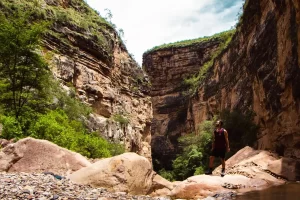
Torotoro National Park, located in Potosí Department Bolivia, is one of the 10 country’s most beautiful and underrated places for visitors.
It’s a hidden gem for adventurous travelers, offering a unique combination of natural beauty and geological wonders.
Spanning over 65,000 hectares, the park is known for its dramatic canyons, towering cliffs, and lush valleys.
One of its most striking features is, without a doubt, the Torotoro Canyon, a breathtaking gorge that is perfect for hiking and, in addition, offers panoramic views.
The park is also famous for its paleontological sites, where visitors can see fossilized dinosaur footprints, some of which are over 65 million years old.
These footprints, embedded in the park’s sedimentary rock formations, offer a fascinating peek into the prehistoric past and are a highlight for both tourists and researchers.
For adventure seekers, the park provides activities like rock climbing, caving, and trekking.
Its diverse ecosystems also make it a haven for nature lovers and birdwatchers, with plenty of unique flora and fauna to spot.
The local culture certainly adds to the experience, with ample opportunities to connect with indigenous communities and, furthermore, learn about their traditions.
Visitors typically start their journey from the nearby town of Torotoro, which serves as a base for exploring the park.
Accommodations in the area range from basic hostels to more comfortable lodges, so there’s something for every budget.
With its stunning landscapes, rich history, and exciting adventure opportunities, Torotoro National Park is a must-see destination for anyone wanting to explore Bolivia’s natural wonders.
6. Potosí, Bolivia:
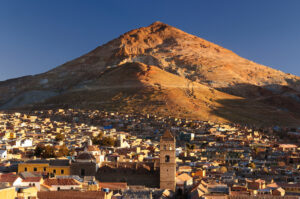
Potosí, Bolivia, is one of the top 10 most beautiful places for visitors, offering a charming blend of history, culture, and stunning architecture.
Nestled at over 4,000 meters (13,123 feet) above sea level, it’s one of the highest cities in the world, providing breathtaking views of the surrounding Andes mountains.
The city’s most famous landmark is Cerro Rico, or “Rich Mountain,” which was once home to the world’s largest silver mine.
Visitors can explore the remnants of this mining history, with guided tours that reveal the harsh conditions miners faced and the important role silver extraction played in shaping Bolivia’s economy.
The experience is both educational and moving, offering a glimpse into the resilience of the local community.
Potosí is also known for its colonial architecture, with many churches, plazas, and buildings that reflect the city’s prosperous past.
Key sites like the San Francisco Church and the Casa de la Moneda (Mint House) showcase beautiful designs and historical artifacts.
For a more immersive experience, visitors can explore the lively markets, where they can not only taste local dishes like salteñas and api but also shop for handmade crafts.
Potosí is also a gateway to the nearby Uyuni Salt Flats, making it a perfect stop for travelers exploring Bolivia’s natural wonders.
With its rich history, vibrant culture, and stunning landscapes, Potosí is a must-visit destination that offers something for every kind of traveler, whether you’re an adventurer, history lover, or culture enthusiast.
7. Madidi National Park, Bolivia:
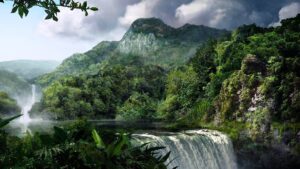
Madidi National Park, located in the northern region of Bolivia, is one of the top 10 most beautiful places for visitors.
It’s a stunning destination for nature lovers and adventure seekers alike, covering over 18,900 square kilometers of land.
The park is one of the most biodiverse places on Earth, offering a unique chance to explore its diverse ecosystems, which range from Andean mountains to lush tropical rainforests.
Visitors can expect to encounter an incredible variety of wildlife, including jaguars, capybaras, and over 1,000 species of birds, making it a paradise for birdwatchers.
The park is also home to countless endemic plant species and vibrant flora, creating a beautiful setting for hiking and photography.
The park’s diverse landscapes offer plenty of activities for tourists, from trekking through dense jungles and canoeing along winding rivers to simply relaxing in its tranquil environment.
Guided tours are available, led by knowledgeable local guides who can, in addition, share insights into the park’s ecology and the traditions of nearby indigenous communities.
For those interested in cultural experiences, Madidi is close to several indigenous communities, where you can learn about traditional lifestyles and conservation efforts.
The best time to visit is during the dry season, from May to October, when the trails are easier to navigate.
Madidi National Park isn’t just a place to visit—it’s an invitation to immerse yourself in one of the world’s most pristine natural environments.
Whether you’re after adventure, peace, or a deeper understanding of biodiversity, Madidi promises an unforgettable experience.
8. Oruro Carnival, Bolivia:
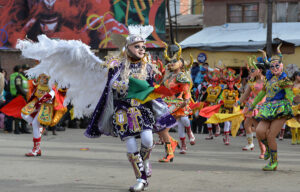
The Oruro Carnival, held every year in Oruro, Bolivia, is one of the most vibrant and culturally rich festivals in South America.
Recognized by UNESCO as a Masterpiece of the Oral and Intangible Heritage of Humanity, it draws thousands of tourists from around the world who come to experience the unique mix of indigenous traditions and Catholic influences.
This fusion creates a fascinating cultural tapestry that captivates many visitors.
Taking place in February, the carnival lasts several days, with the grand parade being the highlight.
The parade is filled with colorful costumes, traditional music, and intricate dances.
The participants, known as “carnival dancers,” wear elaborate outfits that represent Bolivia’s diverse cultural heritage, with everything from folkloric themes to indigenous symbols.
The most iconic dance is the Diablada, or “Dance of the Devils,” which symbolizes the struggle between good and evil and is a dramatic portrayal of this eternal battle.
Visitors can also dive deeper into the local culture by exploring the lively markets, tasting traditional Bolivian dishes, and chatting with the warm, welcoming locals.
The whole atmosphere is electric, with the sounds of brass bands and drum rhythms filling the air, thereby creating an unforgettable experience.
Beyond the carnival, Oruro itself is rich in history and culture, offering attractions like the Basilica of Socavón and stunning views of the surrounding Andes mountains.
For anyone looking for an authentic cultural experience, the Oruro Carnival is an unmissable event and a must-visit destination.
9. Valle de la Luna (Moon Valley), Bolivia:
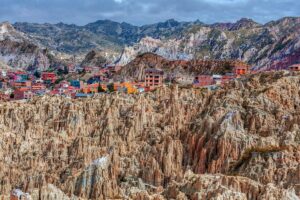
Valle de la Luna, or Moon Valley, is a stunning natural wonder just outside La Paz, Bolivia. Known for its otherworldly landscape, the valley is made up of eroded rock formations and clay spires that resemble a lunar surface.
These unique geological features were shaped by centuries of wind and water erosion, creating a surreal terrain that fascinates all who visit.
As you explore the valley, you’ll encounter towering rock pillars and deep ravines, all framed by the majestic Andes Mountains.
The area offers a peaceful escape from the bustling city, with walking trails that, in addition, let you fully immerse yourself in the striking environment.
Along the way, you can enjoy the unique flora and fauna that thrive in this arid landscape.
For photography lovers, Valle de la Luna is a dream come true.
The landscape provides endless opportunities to snap incredible photos, especially during sunrise and sunset, when the soft light casts dramatic shadows across the formations.
The site is easily accessible, making it a popular day trip for both locals and tourists.
If you’re planning to visit, be sure to bring water and sun protection, as the high altitude can lead to dehydration.
Valle de la Luna offers a truly unforgettable experience, with its breathtaking views and, moreover, its peaceful atmosphere.
10. Sajama National Park, Bolivia:
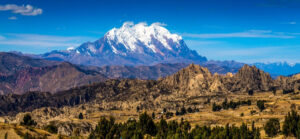
Sajama National Park, located in the western highlands of Bolivia, is a stunning destination that combines natural beauty with rich cultural heritage.
Established in 1939, it is the oldest national park in Bolivia, covering over 1,000 square kilometers.
The park is dominated by the majestic Sajama Volcano, the highest peak in Bolivia at 6,542 meters, and offers breathtaking landscapes ranging from high-altitude grasslands to alpine forests.
Sajama is also home to a diverse array of wildlife, including the endangered Andean condor, vicuñas, and the elusive Andean fox.
Birdwatchers and nature lovers will be delighted, as over 200 bird species have been recorded in the area.
The park provides plenty of opportunities for outdoor activities, including trekking, mountaineering, and exploring the picturesque hot springs scattered throughout the region.
The trails offer stunning views of snow-capped peaks, glacial lakes, and unique rock formations, making it a perfect spot for photographers and adventurers alike.
Culturally, the park holds deep significance for the indigenous Aymara people, who, in fact, have lived in the area for centuries.
Visitors can explore local traditions, visit ancient archaeological sites, and experience traditional villages.
Sajama National Park is more than just a place for outdoor activities—it’s a place where nature and culture come together, providing a truly enriching experience for anyone who visits.

